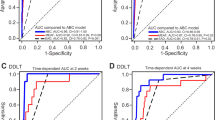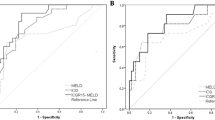Abstract
Purpose
According to the current criteria, the diagnosis of early allograft dysfunction usually cannot be established before the end of the first week after liver transplantation. Thus, early predictive tests for detecting allograft dysfunction are still warranted to prevent allograft failure. This study was undertaken to assess the role of low serum factor V activity as an early prognostic factor (postoperative day 2) after liver transplantation.
Methods
A retrospective review of all consecutive adult patients who underwent first orthotopic whole-graft liver transplant at our institution between March 2002 and June 2011 was undertaken. Primary endpoint was graft failure within 90 days after transplantation.
Results
Of all 105 patients analyzed in this study, 39 (37.1 %) were female and 66 (62.9 %) were male. Mean age was 52.7 ± 11.7 years, and median follow-up period was 2474 ± 164 days. There were overall 33 (31.4 %) deaths, 13 of those occurring on the first 90 post-transplant days. Multivariate analysis demonstrated that serum factor V lower than 41.5 % and female gender had a negative impact not only on allograft failure/death within 90 days after transplantation (RR = 5.30, CI = 1.40–20.2, p = 0.015 and RR = 5.23, CI = 1.53–21.33, p = 0.008) but also on overall mortality. For prediction of allograft failure/death occurring during the first 3 months, serum factor V level of 41.5 % or lower exhibited a specificity of 87.9 %, a sensitivity of 42.9 %, an accuracy of 81.9 %, a positive predictive value of 35.3 %, and a negative predictive value of 90.9 %.
Conclusions
Assessment of serum factor V levels on postoperative day 2 might be a promising prognostic tool for early prediction of inferior outcomes after liver transplantation.




Similar content being viewed by others
Abbreviations
- ALT:
-
Alanine aminotransferase
- AST:
-
Aspartate aminotransferase
- EAD:
-
Early allograft dysfunction
- FFP:
-
Fresh frozen plasma
- MELD score:
-
Model for End-Stage Liver Disease
- POD:
-
Postoperative day
- RBC:
-
Red blood cell unit
References
Wong CS, Lee WC, Jenq CC et al (2010) Scoring short-term mortality after liver transplantation. Liver Transpl 16:138–46. doi:10.1002/lt.21969
Eisenbach C, Encke J, Merle U et al (2009) An early increase in gamma glutamyltranspeptidase and low aspartate aminotransferase peak values are associated with superior outcomes after orthotopic liver transplantation. Transplant Proc 41:1727–30. doi:10.1016/j.transproceed.2009.01.084
Habib S, Berk B, Chang CC et al (2006) MELD and prediction of post-liver transplantation survival. Liver Transpl 12:440–7
Olthoff KM, Kulik L, Samstein B et al (2010) Validation of a current definition of early allograft dysfunction in liver transplant recipients and analysis of risk factors. Liver Transpl 16:943–9. doi:10.1002/lt.22091
Bernuau J, Goudeau A, Poynard T et al (1986) Multivariate analysis of prognostic factors in fulminant hepatitis B. Hepatology 6:648–51
Bismuth H, Samuel D, Castaing D et al (1995) Orthotopic liver transplantation in fulminant and subfulminant hepatitis. The Paul Brousse experience. Ann Surg 222:109–19
Elinav E, Ben-Dov I, Hai-Am E, Ackerman Z, Ofran Y (2005) The predictive value of admission and follow up factor V and VII levels in patients with acute hepatitis and coagulopathy. J Hepatol 42:82–6
Doyle HR, Dvorchik I, Mitchell S et al (1994) Early death or retransplantation in adults after orthotopic liver transplantation. Can outcome be predicted? Transplantation 57:1028–36
Stock PG, Estrin JA, Fryd DS et al (1989) Factors influencing early survival after liver transplantation. Am J Surg 157:215–9
Shakil AO, Kramer D, Mazariegos GV, Fung JJ, Rakela J (2000) Acute liver failure: clinical features, outcome analysis, and applicability of prognostic criteria. Liver Transpl 6:163–9
Lesurtel M, Raptis DA, Melloul E et al (2014) Low platelet counts after liver transplantation predict early posttransplant survival: the 60-5 criterion. Liver Transpl 20:147–55. doi:10.1002/lt.23759
Wagener G, Raffel B, Young AT, Minhaz M, Emond J (2013) Predicting early allograft failure and mortality after liver transplantation: the role of the postoperative model for end-stage liver disease score. Liver Transpl 19:534–42. doi:10.1002/lt.23634
Kruel CR, Chedid A, Grezzana-Filho T, Leipnitz I (2014) Can we go further in translational medicine with silver-standard criteria for early allograft dysfunction? Liver Transpl 20:500–1. doi:10.1002/lt.23815
Stockmann M, Lock JF, Malinowski M, Neuhaus P (2010) Evaluation of early liver graft performance by the indocyanine green plasma disappearance rate. Liver Transpl 16:793–4. doi:10.1002/lt.22068, author reply 795-6
Lock JF, Schwabauer E, Martus P et al (2010) Early diagnosis of primary nonfunction and indication for reoperation after liver transplantation. Liver Transpl 16:172–80. doi:10.1002/lt.21973
Pereira LM, Langley PG, Hayllar KM, Tredger JM, Williams JM (1992) Coagulation factor V and VIII/V ratio as predictors of outcome in paracetamol induced fulminant hepatic failure: relation to other prognostic indicators. Gut 33:98–102
Thomassen MC, Castoldi E, Tans G et al (2003) Endogenous factor V synthesis in megakaryocytes contributes negligibly to the platelet factor V pool. Haematologica 88:1150–6
Harimoto N, Shirabe K, Nakagawara H et al (2013) Prognostic factors affecting survival at recurrence of hepatocellular carcinoma after living-donor liver transplantation: with special reference to neutrophil/lymphocyte ratio. Transplantation 96:1008–12. doi:10.1097/TP
van den Broek MA, Olde Damink SW, Winkens B et al (2010) Procalcitonin as a prognostic marker for infectious complications in liver transplant recipients in an intensive care unit. Liver Transpl 16:402–10. doi:10.1002/lt.21987
Waki K (2006) UNOS Liver Registry: ten year survivals. Clin Transpl 29–39
Burra P, De Martin E, Gitto S, Villa E (2013) Influence of age and gender before and after liver transplantation. Liver Transpl 19:122–34. doi:10.1002/lt.23574
Conflicts of Interest
None.
Compliance with Ethical Standards
All patients consented before being included in this study. This study complies with ethical standards and was approved by the local IRB committee.
Authorship
M.C.Z. participated in study conception and design, acquisition of the research data, analysis and interpretation of data, and writing of the manuscript; M.F.C and C.R.P.K. participated in study conception and design, analysis and interpretation of data, and writing of the manuscript; L.S.G. participated in study conception and design, analysis and interpretation of data, and critical revision of the manuscript; A.D.C., T.J.M.G.F., I.L., A.A, M.R.A.S., M.G.C., and C.D.P.K. participated in study conception and design, analysis and interpretation of data, and critical revision of the manuscript.
Funding
This study was not supported by any funding.
Author information
Authors and Affiliations
Corresponding author
Rights and permissions
About this article
Cite this article
Zulian, M.C., Chedid, M.F., Chedid, A.D. et al. Low serum factor V level: early predictor of allograft failure and death following liver transplantation. Langenbecks Arch Surg 400, 589–597 (2015). https://doi.org/10.1007/s00423-015-1290-2
Received:
Accepted:
Published:
Issue Date:
DOI: https://doi.org/10.1007/s00423-015-1290-2




